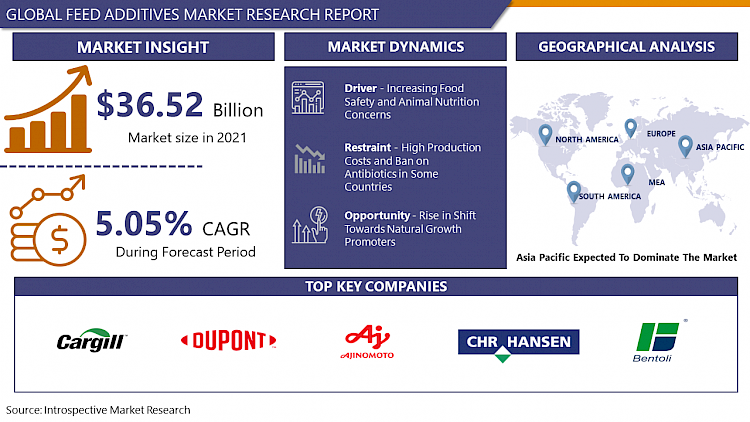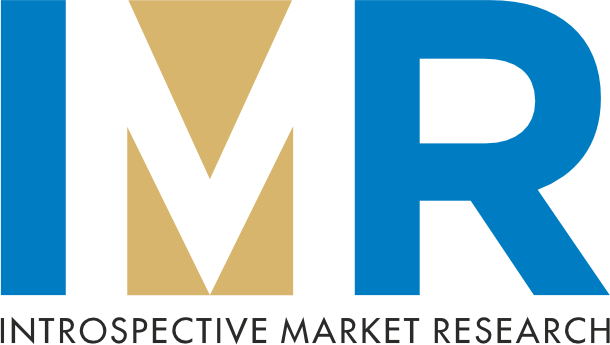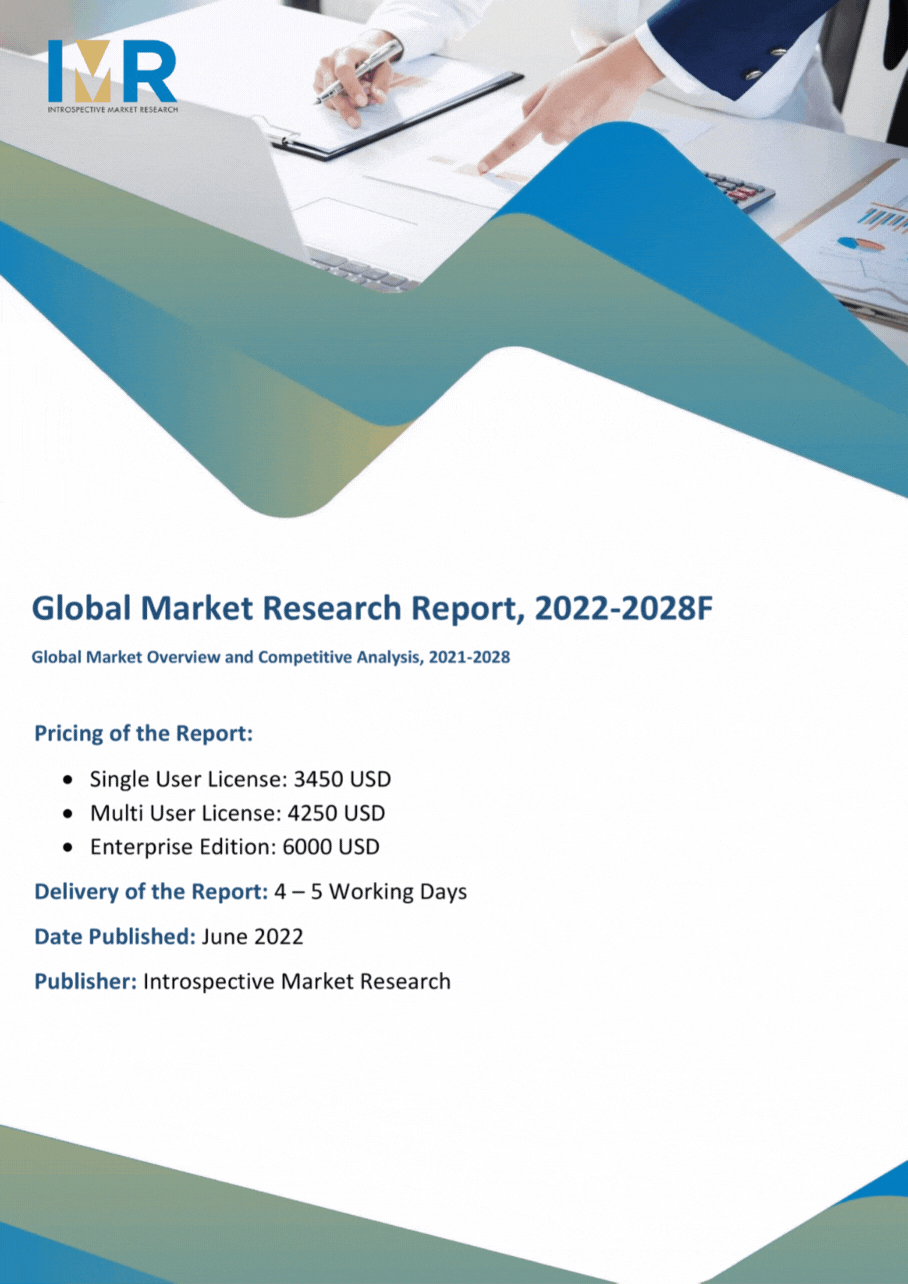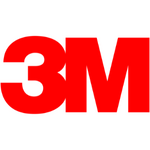Feed Additives Market Overview
Global Feed Additives Market was valued at USD 36.52 billion in 2021 and is expected to reach USD 51.56 billion by the year 2028, at a CAGR of 5.05%.
Feed additives are nutritional supplements that are added to improve the quality of animal derived products such as milk, meat, eggs, etc. It usually consists of minerals, vitamins, amino acids and other essential nutrients that ensure optimum health of animals and prevent diseases.
An increase in demand from farmers for global food demand, creating a positive impact on the feed additives market. The Asia Pacific region will dominate the global feed additive market due to its large livestock population and its growth rate. In addition, the region has witnessed an increase in feed mills and feed production, especially in countries such as India and Japan.

Scope of the Feed Additives Market
Feed additives are products that enhance the nutrition of animals and are added to the feed to provide complete nutrition to farm animals. The end consumers of feed additives are feed mills that manufacture compound feeds for animals. Market growth does not include additional water purchased from farmers to complement the quality of home-cooked meals.
The market was segmented by geography, type of animal and type of additive. The market is showing a modest growth rate and is expected to remain the same over the forecast period.
Market Segmentation
Players Covered in Feed Additives Market are:
- Cargill (US)
- ADM (US)
- Evonik (Germany)
- DuPont (US)
- BASF (Germany)
- DSM (Netherlands)
- Ajinomoto (Japan)
- Novozymes (Denmark)
- Chr. Hansen (Denmark)
- TEGASA (Spain)
- Nutreco (Netherlands)
- Kemin Industries Inc. (US)
- Adisseo (France)
- Alltech (US)
- Palital Feed Additives B.V (Netherlands)
- Global Nutrition International (France)
- Centafarm SRL (Italy)
- Bentoli (US)
- NUQO Feed Additives (France)
- Novus International Inc. (US)
|
Global Feed Additives Market |
|||
|
Base Year: |
2021 |
Forecast Period: |
2022-2028 |
|
Historical Data: |
2016 to 2020 |
Market Size in 2021: |
USD 36.52 Bn. |
|
Forecast Period 2022-28 CAGR: |
5.05% |
Market Size in 2028: |
USD 51.56 Bn. |
|
Segments Covered: |
By Type |
|
|
|
By Source |
|
||
|
By Form |
|
||
|
By Livestock |
|
||
|
By Region |
|
||
|
Key Market Drivers: |
|
||
|
Key Market Restraints: |
|
||
|
Key Opportunities: |
|
||
|
Companies Covered in the report: |
|
||
Chapter 1: Introduction
1.1 Research Objectives
1.2 Research Methodology
1.3 Research Process
1.4 Scope and Coverage
1.4.1 Market Definition
1.4.2 Key Questions Answered
1.5 Market Segmentation
Chapter 2:Executive Summary
Chapter 3:Growth Opportunities By Segment
3.1 By Type
3.2 By Source
3.3 By Form
3.4 By Livestock
Chapter 4: Market Landscape
4.1 Porter's Five Forces Analysis
4.1.1 Bargaining Power of Supplier
4.1.2 Threat of New Entrants
4.1.3 Threat of Substitutes
4.1.4 Competitive Rivalry
4.1.5 Bargaining Power Among Buyers
4.2 Industry Value Chain Analysis
4.3 Market Dynamics
4.3.1 Drivers
4.3.2 Restraints
4.3.3 Opportunities
4.5.4 Challenges
4.4 Pestle Analysis
4.5 Technological Roadmap
4.6 Regulatory Landscape
4.7 SWOT Analysis
4.8 Price Trend Analysis
4.9 Patent Analysis
4.10 Analysis of the Impact of Covid-19
4.10.1 Impact on the Overall Market
4.10.2 Impact on the Supply Chain
4.10.3 Impact on the Key Manufacturers
4.10.4 Impact on the Pricing
Chapter 5: Feed Additives Market by Type
5.1 Feed Additives Market Overview Snapshot and Growth Engine
5.2 Feed Additives Market Overview
5.3 Amino Acids
5.3.1 Introduction and Market Overview
5.3.2 Historic and Forecasted Market Size (2016-2028F)
5.3.3 Key Market Trends, Growth Factors and Opportunities
5.3.4 Amino Acids: Grographic Segmentation
5.4 Antibiotics/Antibacterial
5.4.1 Introduction and Market Overview
5.4.2 Historic and Forecasted Market Size (2016-2028F)
5.4.3 Key Market Trends, Growth Factors and Opportunities
5.4.4 Antibiotics/Antibacterial: Grographic Segmentation
5.5 Probiotics
5.5.1 Introduction and Market Overview
5.5.2 Historic and Forecasted Market Size (2016-2028F)
5.5.3 Key Market Trends, Growth Factors and Opportunities
5.5.4 Probiotics: Grographic Segmentation
5.6 Vitamins
5.6.1 Introduction and Market Overview
5.6.2 Historic and Forecasted Market Size (2016-2028F)
5.6.3 Key Market Trends, Growth Factors and Opportunities
5.6.4 Vitamins: Grographic Segmentation
5.7 Others
5.7.1 Introduction and Market Overview
5.7.2 Historic and Forecasted Market Size (2016-2028F)
5.7.3 Key Market Trends, Growth Factors and Opportunities
5.7.4 Others: Grographic Segmentation
Chapter 6: Feed Additives Market by Source
6.1 Feed Additives Market Overview Snapshot and Growth Engine
6.2 Feed Additives Market Overview
6.3 Synthetic
6.3.1 Introduction and Market Overview
6.3.2 Historic and Forecasted Market Size (2016-2028F)
6.3.3 Key Market Trends, Growth Factors and Opportunities
6.3.4 Synthetic: Grographic Segmentation
6.4 Natural
6.4.1 Introduction and Market Overview
6.4.2 Historic and Forecasted Market Size (2016-2028F)
6.4.3 Key Market Trends, Growth Factors and Opportunities
6.4.4 Natural: Grographic Segmentation
Chapter 7: Feed Additives Market by Form
7.1 Feed Additives Market Overview Snapshot and Growth Engine
7.2 Feed Additives Market Overview
7.3 Dry
7.3.1 Introduction and Market Overview
7.3.2 Historic and Forecasted Market Size (2016-2028F)
7.3.3 Key Market Trends, Growth Factors and Opportunities
7.3.4 Dry: Grographic Segmentation
7.4 Liquid
7.4.1 Introduction and Market Overview
7.4.2 Historic and Forecasted Market Size (2016-2028F)
7.4.3 Key Market Trends, Growth Factors and Opportunities
7.4.4 Liquid: Grographic Segmentation
Chapter 8: Feed Additives Market by Livestock
8.1 Feed Additives Market Overview Snapshot and Growth Engine
8.2 Feed Additives Market Overview
8.3 Poultry
8.3.1 Introduction and Market Overview
8.3.2 Historic and Forecasted Market Size (2016-2028F)
8.3.3 Key Market Trends, Growth Factors and Opportunities
8.3.4 Poultry: Grographic Segmentation
8.4 Ruminants
8.4.1 Introduction and Market Overview
8.4.2 Historic and Forecasted Market Size (2016-2028F)
8.4.3 Key Market Trends, Growth Factors and Opportunities
8.4.4 Ruminants: Grographic Segmentation
8.5 Swine
8.5.1 Introduction and Market Overview
8.5.2 Historic and Forecasted Market Size (2016-2028F)
8.5.3 Key Market Trends, Growth Factors and Opportunities
8.5.4 Swine: Grographic Segmentation
8.6 Aquatic Animals
8.6.1 Introduction and Market Overview
8.6.2 Historic and Forecasted Market Size (2016-2028F)
8.6.3 Key Market Trends, Growth Factors and Opportunities
8.6.4 Aquatic Animals: Grographic Segmentation
8.7 Others
8.7.1 Introduction and Market Overview
8.7.2 Historic and Forecasted Market Size (2016-2028F)
8.7.3 Key Market Trends, Growth Factors and Opportunities
8.7.4 Others: Grographic Segmentation
Chapter 9: Company Profiles and Competitive Analysis
9.1 Competitive Landscape
9.1.1 Competitive Positioning
9.1.2 Feed Additives Sales and Market Share By Players
9.1.3 Industry BCG Matrix
9.1.4 Ansoff Matrix
9.1.5 Feed Additives Industry Concentration Ratio (CR5 and HHI)
9.1.6 Top 5 Feed Additives Players Market Share
9.1.7 Mergers and Acquisitions
9.1.8 Business Strategies By Top Players
9.2 CARGILL
9.2.1 Company Overview
9.2.2 Key Executives
9.2.3 Company Snapshot
9.2.4 Operating Business Segments
9.2.5 Product Portfolio
9.2.6 Business Performance
9.2.7 Key Strategic Moves and Recent Developments
9.2.8 SWOT Analysis
9.3 ADM
9.4 EVONIK
9.5 DUPONT
9.6 BASF
9.7 DSM
9.8 AJINOMOTO
9.9 NOVOZYMES
9.10 CHR. HANSEN
9.11 TEGASA
9.12 NUTRECO
9.13 KEMIN INDUSTRIES INC.
9.14 ADISSEO
9.15 ALLTECH
9.16 PALITAL FEED ADDITIVES B.V
9.17 GLOBAL NUTRITION INTERNATIONAL
9.18 CENTAFARM SRL
9.19 BENTOLI
9.20 NUQO FEED ADDITIVES
9.21 NOVUS INTERNATIONAL INC
9.22 OTHER MAJOR PLAYERS
Chapter 10: Global Feed Additives Market Analysis, Insights and Forecast, 2016-2028
10.1 Market Overview
10.2 Historic and Forecasted Market Size By Type
10.2.1 Amino Acids
10.2.2 Antibiotics/Antibacterial
10.2.3 Probiotics
10.2.4 Vitamins
10.2.5 Others
10.3 Historic and Forecasted Market Size By Source
10.3.1 Synthetic
10.3.2 Natural
10.4 Historic and Forecasted Market Size By Form
10.4.1 Dry
10.4.2 Liquid
10.5 Historic and Forecasted Market Size By Livestock
10.5.1 Poultry
10.5.2 Ruminants
10.5.3 Swine
10.5.4 Aquatic Animals
10.5.5 Others
Chapter 11: North America Feed Additives Market Analysis, Insights and Forecast, 2016-2028
11.1 Key Market Trends, Growth Factors and Opportunities
11.2 Impact of Covid-19
11.3 Key Players
11.4 Key Market Trends, Growth Factors and Opportunities
11.4 Historic and Forecasted Market Size By Type
11.4.1 Amino Acids
11.4.2 Antibiotics/Antibacterial
11.4.3 Probiotics
11.4.4 Vitamins
11.4.5 Others
11.5 Historic and Forecasted Market Size By Source
11.5.1 Synthetic
11.5.2 Natural
11.6 Historic and Forecasted Market Size By Form
11.6.1 Dry
11.6.2 Liquid
11.7 Historic and Forecasted Market Size By Livestock
11.7.1 Poultry
11.7.2 Ruminants
11.7.3 Swine
11.7.4 Aquatic Animals
11.7.5 Others
11.8 Historic and Forecast Market Size by Country
11.8.1 U.S.
11.8.2 Canada
11.8.3 Mexico
Chapter 12: Europe Feed Additives Market Analysis, Insights and Forecast, 2016-2028
12.1 Key Market Trends, Growth Factors and Opportunities
12.2 Impact of Covid-19
12.3 Key Players
12.4 Key Market Trends, Growth Factors and Opportunities
12.4 Historic and Forecasted Market Size By Type
12.4.1 Amino Acids
12.4.2 Antibiotics/Antibacterial
12.4.3 Probiotics
12.4.4 Vitamins
12.4.5 Others
12.5 Historic and Forecasted Market Size By Source
12.5.1 Synthetic
12.5.2 Natural
12.6 Historic and Forecasted Market Size By Form
12.6.1 Dry
12.6.2 Liquid
12.7 Historic and Forecasted Market Size By Livestock
12.7.1 Poultry
12.7.2 Ruminants
12.7.3 Swine
12.7.4 Aquatic Animals
12.7.5 Others
12.8 Historic and Forecast Market Size by Country
12.8.1 Germany
12.8.2 U.K.
12.8.3 France
12.8.4 Italy
12.8.5 Russia
12.8.6 Spain
12.8.7 Rest of Europe
Chapter 13: Asia-Pacific Feed Additives Market Analysis, Insights and Forecast, 2016-2028
13.1 Key Market Trends, Growth Factors and Opportunities
13.2 Impact of Covid-19
13.3 Key Players
13.4 Key Market Trends, Growth Factors and Opportunities
13.4 Historic and Forecasted Market Size By Type
13.4.1 Amino Acids
13.4.2 Antibiotics/Antibacterial
13.4.3 Probiotics
13.4.4 Vitamins
13.4.5 Others
13.5 Historic and Forecasted Market Size By Source
13.5.1 Synthetic
13.5.2 Natural
13.6 Historic and Forecasted Market Size By Form
13.6.1 Dry
13.6.2 Liquid
13.7 Historic and Forecasted Market Size By Livestock
13.7.1 Poultry
13.7.2 Ruminants
13.7.3 Swine
13.7.4 Aquatic Animals
13.7.5 Others
13.8 Historic and Forecast Market Size by Country
13.8.1 China
13.8.2 India
13.8.3 Japan
13.8.4 Singapore
13.8.5 Australia
13.8.6 New Zealand
13.8.7 Rest of APAC
Chapter 14: Middle East & Africa Feed Additives Market Analysis, Insights and Forecast, 2016-2028
14.1 Key Market Trends, Growth Factors and Opportunities
14.2 Impact of Covid-19
14.3 Key Players
14.4 Key Market Trends, Growth Factors and Opportunities
14.4 Historic and Forecasted Market Size By Type
14.4.1 Amino Acids
14.4.2 Antibiotics/Antibacterial
14.4.3 Probiotics
14.4.4 Vitamins
14.4.5 Others
14.5 Historic and Forecasted Market Size By Source
14.5.1 Synthetic
14.5.2 Natural
14.6 Historic and Forecasted Market Size By Form
14.6.1 Dry
14.6.2 Liquid
14.7 Historic and Forecasted Market Size By Livestock
14.7.1 Poultry
14.7.2 Ruminants
14.7.3 Swine
14.7.4 Aquatic Animals
14.7.5 Others
14.8 Historic and Forecast Market Size by Country
14.8.1 Turkey
14.8.2 Saudi Arabia
14.8.3 Iran
14.8.4 UAE
14.8.5 Africa
14.8.6 Rest of MEA
Chapter 15: South America Feed Additives Market Analysis, Insights and Forecast, 2016-2028
15.1 Key Market Trends, Growth Factors and Opportunities
15.2 Impact of Covid-19
15.3 Key Players
15.4 Key Market Trends, Growth Factors and Opportunities
15.4 Historic and Forecasted Market Size By Type
15.4.1 Amino Acids
15.4.2 Antibiotics/Antibacterial
15.4.3 Probiotics
15.4.4 Vitamins
15.4.5 Others
15.5 Historic and Forecasted Market Size By Source
15.5.1 Synthetic
15.5.2 Natural
15.6 Historic and Forecasted Market Size By Form
15.6.1 Dry
15.6.2 Liquid
15.7 Historic and Forecasted Market Size By Livestock
15.7.1 Poultry
15.7.2 Ruminants
15.7.3 Swine
15.7.4 Aquatic Animals
15.7.5 Others
15.8 Historic and Forecast Market Size by Country
15.8.1 Brazil
15.8.2 Argentina
15.8.3 Rest of SA
Chapter 16 Investment Analysis
Chapter 17 Analyst Viewpoint and Conclusion
|
Global Feed Additives Market |
|||
|
Base Year: |
2021 |
Forecast Period: |
2022-2028 |
|
Historical Data: |
2016 to 2020 |
Market Size in 2021: |
USD 36.52 Bn. |
|
Forecast Period 2022-28 CAGR: |
5.05% |
Market Size in 2028: |
USD 51.56 Bn. |
|
Segments Covered: |
By Type |
|
|
|
By Source |
|
||
|
By Form |
|
||
|
By Livestock |
|
||
|
By Region |
|
||
|
Key Market Drivers: |
|
||
|
Key Market Restraints: |
|
||
|
Key Opportunities: |
|
||
|
Companies Covered in the report: |
|
||
LIST OF TABLES
TABLE 001. EXECUTIVE SUMMARY
TABLE 002. FEED ADDITIVES MARKET BARGAINING POWER OF SUPPLIERS
TABLE 003. FEED ADDITIVES MARKET BARGAINING POWER OF CUSTOMERS
TABLE 004. FEED ADDITIVES MARKET COMPETITIVE RIVALRY
TABLE 005. FEED ADDITIVES MARKET THREAT OF NEW ENTRANTS
TABLE 006. FEED ADDITIVES MARKET THREAT OF SUBSTITUTES
TABLE 007. FEED ADDITIVES MARKET BY TYPE
TABLE 008. AMINO ACIDS MARKET OVERVIEW (2016-2028)
TABLE 009. ANTIBIOTICS/ANTIBACTERIAL MARKET OVERVIEW (2016-2028)
TABLE 010. PROBIOTICS MARKET OVERVIEW (2016-2028)
TABLE 011. VITAMINS MARKET OVERVIEW (2016-2028)
TABLE 012. OTHERS MARKET OVERVIEW (2016-2028)
TABLE 013. FEED ADDITIVES MARKET BY SOURCE
TABLE 014. SYNTHETIC MARKET OVERVIEW (2016-2028)
TABLE 015. NATURAL MARKET OVERVIEW (2016-2028)
TABLE 016. FEED ADDITIVES MARKET BY FORM
TABLE 017. DRY MARKET OVERVIEW (2016-2028)
TABLE 018. LIQUID MARKET OVERVIEW (2016-2028)
TABLE 019. FEED ADDITIVES MARKET BY LIVESTOCK
TABLE 020. POULTRY MARKET OVERVIEW (2016-2028)
TABLE 021. RUMINANTS MARKET OVERVIEW (2016-2028)
TABLE 022. SWINE MARKET OVERVIEW (2016-2028)
TABLE 023. AQUATIC ANIMALS MARKET OVERVIEW (2016-2028)
TABLE 024. OTHERS MARKET OVERVIEW (2016-2028)
TABLE 025. NORTH AMERICA FEED ADDITIVES MARKET, BY TYPE (2016-2028)
TABLE 026. NORTH AMERICA FEED ADDITIVES MARKET, BY SOURCE (2016-2028)
TABLE 027. NORTH AMERICA FEED ADDITIVES MARKET, BY FORM (2016-2028)
TABLE 028. NORTH AMERICA FEED ADDITIVES MARKET, BY LIVESTOCK (2016-2028)
TABLE 029. N FEED ADDITIVES MARKET, BY COUNTRY (2016-2028)
TABLE 030. EUROPE FEED ADDITIVES MARKET, BY TYPE (2016-2028)
TABLE 031. EUROPE FEED ADDITIVES MARKET, BY SOURCE (2016-2028)
TABLE 032. EUROPE FEED ADDITIVES MARKET, BY FORM (2016-2028)
TABLE 033. EUROPE FEED ADDITIVES MARKET, BY LIVESTOCK (2016-2028)
TABLE 034. FEED ADDITIVES MARKET, BY COUNTRY (2016-2028)
TABLE 035. ASIA PACIFIC FEED ADDITIVES MARKET, BY TYPE (2016-2028)
TABLE 036. ASIA PACIFIC FEED ADDITIVES MARKET, BY SOURCE (2016-2028)
TABLE 037. ASIA PACIFIC FEED ADDITIVES MARKET, BY FORM (2016-2028)
TABLE 038. ASIA PACIFIC FEED ADDITIVES MARKET, BY LIVESTOCK (2016-2028)
TABLE 039. FEED ADDITIVES MARKET, BY COUNTRY (2016-2028)
TABLE 040. MIDDLE EAST & AFRICA FEED ADDITIVES MARKET, BY TYPE (2016-2028)
TABLE 041. MIDDLE EAST & AFRICA FEED ADDITIVES MARKET, BY SOURCE (2016-2028)
TABLE 042. MIDDLE EAST & AFRICA FEED ADDITIVES MARKET, BY FORM (2016-2028)
TABLE 043. MIDDLE EAST & AFRICA FEED ADDITIVES MARKET, BY LIVESTOCK (2016-2028)
TABLE 044. FEED ADDITIVES MARKET, BY COUNTRY (2016-2028)
TABLE 045. SOUTH AMERICA FEED ADDITIVES MARKET, BY TYPE (2016-2028)
TABLE 046. SOUTH AMERICA FEED ADDITIVES MARKET, BY SOURCE (2016-2028)
TABLE 047. SOUTH AMERICA FEED ADDITIVES MARKET, BY FORM (2016-2028)
TABLE 048. SOUTH AMERICA FEED ADDITIVES MARKET, BY LIVESTOCK (2016-2028)
TABLE 049. FEED ADDITIVES MARKET, BY COUNTRY (2016-2028)
TABLE 050. CARGILL: SNAPSHOT
TABLE 051. CARGILL: BUSINESS PERFORMANCE
TABLE 052. CARGILL: PRODUCT PORTFOLIO
TABLE 053. CARGILL: KEY STRATEGIC MOVES AND DEVELOPMENTS
TABLE 053. ADM: SNAPSHOT
TABLE 054. ADM: BUSINESS PERFORMANCE
TABLE 055. ADM: PRODUCT PORTFOLIO
TABLE 056. ADM: KEY STRATEGIC MOVES AND DEVELOPMENTS
TABLE 056. EVONIK: SNAPSHOT
TABLE 057. EVONIK: BUSINESS PERFORMANCE
TABLE 058. EVONIK: PRODUCT PORTFOLIO
TABLE 059. EVONIK: KEY STRATEGIC MOVES AND DEVELOPMENTS
TABLE 059. DUPONT: SNAPSHOT
TABLE 060. DUPONT: BUSINESS PERFORMANCE
TABLE 061. DUPONT: PRODUCT PORTFOLIO
TABLE 062. DUPONT: KEY STRATEGIC MOVES AND DEVELOPMENTS
TABLE 062. BASF: SNAPSHOT
TABLE 063. BASF: BUSINESS PERFORMANCE
TABLE 064. BASF: PRODUCT PORTFOLIO
TABLE 065. BASF: KEY STRATEGIC MOVES AND DEVELOPMENTS
TABLE 065. DSM: SNAPSHOT
TABLE 066. DSM: BUSINESS PERFORMANCE
TABLE 067. DSM: PRODUCT PORTFOLIO
TABLE 068. DSM: KEY STRATEGIC MOVES AND DEVELOPMENTS
TABLE 068. AJINOMOTO: SNAPSHOT
TABLE 069. AJINOMOTO: BUSINESS PERFORMANCE
TABLE 070. AJINOMOTO: PRODUCT PORTFOLIO
TABLE 071. AJINOMOTO: KEY STRATEGIC MOVES AND DEVELOPMENTS
TABLE 071. NOVOZYMES: SNAPSHOT
TABLE 072. NOVOZYMES: BUSINESS PERFORMANCE
TABLE 073. NOVOZYMES: PRODUCT PORTFOLIO
TABLE 074. NOVOZYMES: KEY STRATEGIC MOVES AND DEVELOPMENTS
TABLE 074. CHR. HANSEN: SNAPSHOT
TABLE 075. CHR. HANSEN: BUSINESS PERFORMANCE
TABLE 076. CHR. HANSEN: PRODUCT PORTFOLIO
TABLE 077. CHR. HANSEN: KEY STRATEGIC MOVES AND DEVELOPMENTS
TABLE 077. TEGASA: SNAPSHOT
TABLE 078. TEGASA: BUSINESS PERFORMANCE
TABLE 079. TEGASA: PRODUCT PORTFOLIO
TABLE 080. TEGASA: KEY STRATEGIC MOVES AND DEVELOPMENTS
TABLE 080. NUTRECO: SNAPSHOT
TABLE 081. NUTRECO: BUSINESS PERFORMANCE
TABLE 082. NUTRECO: PRODUCT PORTFOLIO
TABLE 083. NUTRECO: KEY STRATEGIC MOVES AND DEVELOPMENTS
TABLE 083. KEMIN INDUSTRIES INC.: SNAPSHOT
TABLE 084. KEMIN INDUSTRIES INC.: BUSINESS PERFORMANCE
TABLE 085. KEMIN INDUSTRIES INC.: PRODUCT PORTFOLIO
TABLE 086. KEMIN INDUSTRIES INC.: KEY STRATEGIC MOVES AND DEVELOPMENTS
TABLE 086. ADISSEO: SNAPSHOT
TABLE 087. ADISSEO: BUSINESS PERFORMANCE
TABLE 088. ADISSEO: PRODUCT PORTFOLIO
TABLE 089. ADISSEO: KEY STRATEGIC MOVES AND DEVELOPMENTS
TABLE 089. ALLTECH: SNAPSHOT
TABLE 090. ALLTECH: BUSINESS PERFORMANCE
TABLE 091. ALLTECH: PRODUCT PORTFOLIO
TABLE 092. ALLTECH: KEY STRATEGIC MOVES AND DEVELOPMENTS
TABLE 092. PALITAL FEED ADDITIVES B.V: SNAPSHOT
TABLE 093. PALITAL FEED ADDITIVES B.V: BUSINESS PERFORMANCE
TABLE 094. PALITAL FEED ADDITIVES B.V: PRODUCT PORTFOLIO
TABLE 095. PALITAL FEED ADDITIVES B.V: KEY STRATEGIC MOVES AND DEVELOPMENTS
TABLE 095. GLOBAL NUTRITION INTERNATIONAL: SNAPSHOT
TABLE 096. GLOBAL NUTRITION INTERNATIONAL: BUSINESS PERFORMANCE
TABLE 097. GLOBAL NUTRITION INTERNATIONAL: PRODUCT PORTFOLIO
TABLE 098. GLOBAL NUTRITION INTERNATIONAL: KEY STRATEGIC MOVES AND DEVELOPMENTS
TABLE 098. CENTAFARM SRL: SNAPSHOT
TABLE 099. CENTAFARM SRL: BUSINESS PERFORMANCE
TABLE 100. CENTAFARM SRL: PRODUCT PORTFOLIO
TABLE 101. CENTAFARM SRL: KEY STRATEGIC MOVES AND DEVELOPMENTS
TABLE 101. BENTOLI: SNAPSHOT
TABLE 102. BENTOLI: BUSINESS PERFORMANCE
TABLE 103. BENTOLI: PRODUCT PORTFOLIO
TABLE 104. BENTOLI: KEY STRATEGIC MOVES AND DEVELOPMENTS
TABLE 104. NUQO FEED ADDITIVES: SNAPSHOT
TABLE 105. NUQO FEED ADDITIVES: BUSINESS PERFORMANCE
TABLE 106. NUQO FEED ADDITIVES: PRODUCT PORTFOLIO
TABLE 107. NUQO FEED ADDITIVES: KEY STRATEGIC MOVES AND DEVELOPMENTS
TABLE 107. NOVUS INTERNATIONAL INC: SNAPSHOT
TABLE 108. NOVUS INTERNATIONAL INC: BUSINESS PERFORMANCE
TABLE 109. NOVUS INTERNATIONAL INC: PRODUCT PORTFOLIO
TABLE 110. NOVUS INTERNATIONAL INC: KEY STRATEGIC MOVES AND DEVELOPMENTS
TABLE 110. OTHER MAJOR PLAYERS: SNAPSHOT
TABLE 111. OTHER MAJOR PLAYERS: BUSINESS PERFORMANCE
TABLE 112. OTHER MAJOR PLAYERS: PRODUCT PORTFOLIO
TABLE 113. OTHER MAJOR PLAYERS: KEY STRATEGIC MOVES AND DEVELOPMENTS
LIST OF FIGURES
FIGURE 001. YEARS CONSIDERED FOR ANALYSIS
FIGURE 002. SCOPE OF THE STUDY
FIGURE 003. FEED ADDITIVES MARKET OVERVIEW BY REGIONS
FIGURE 004. PORTER'S FIVE FORCES ANALYSIS
FIGURE 005. BARGAINING POWER OF SUPPLIERS
FIGURE 006. COMPETITIVE RIVALRYFIGURE 007. THREAT OF NEW ENTRANTS
FIGURE 008. THREAT OF SUBSTITUTES
FIGURE 009. VALUE CHAIN ANALYSIS
FIGURE 010. PESTLE ANALYSIS
FIGURE 011. FEED ADDITIVES MARKET OVERVIEW BY TYPE
FIGURE 012. AMINO ACIDS MARKET OVERVIEW (2016-2028)
FIGURE 013. ANTIBIOTICS/ANTIBACTERIAL MARKET OVERVIEW (2016-2028)
FIGURE 014. PROBIOTICS MARKET OVERVIEW (2016-2028)
FIGURE 015. VITAMINS MARKET OVERVIEW (2016-2028)
FIGURE 016. OTHERS MARKET OVERVIEW (2016-2028)
FIGURE 017. FEED ADDITIVES MARKET OVERVIEW BY SOURCE
FIGURE 018. SYNTHETIC MARKET OVERVIEW (2016-2028)
FIGURE 019. NATURAL MARKET OVERVIEW (2016-2028)
FIGURE 020. FEED ADDITIVES MARKET OVERVIEW BY FORM
FIGURE 021. DRY MARKET OVERVIEW (2016-2028)
FIGURE 022. LIQUID MARKET OVERVIEW (2016-2028)
FIGURE 023. FEED ADDITIVES MARKET OVERVIEW BY LIVESTOCK
FIGURE 024. POULTRY MARKET OVERVIEW (2016-2028)
FIGURE 025. RUMINANTS MARKET OVERVIEW (2016-2028)
FIGURE 026. SWINE MARKET OVERVIEW (2016-2028)
FIGURE 027. AQUATIC ANIMALS MARKET OVERVIEW (2016-2028)
FIGURE 028. OTHERS MARKET OVERVIEW (2016-2028)
FIGURE 029. NORTH AMERICA FEED ADDITIVES MARKET OVERVIEW BY COUNTRY (2016-2028)
FIGURE 030. EUROPE FEED ADDITIVES MARKET OVERVIEW BY COUNTRY (2016-2028)
FIGURE 031. ASIA PACIFIC FEED ADDITIVES MARKET OVERVIEW BY COUNTRY (2016-2028)
FIGURE 032. MIDDLE EAST & AFRICA FEED ADDITIVES MARKET OVERVIEW BY COUNTRY (2016-2028)
FIGURE 033. SOUTH AMERICA FEED ADDITIVES MARKET OVERVIEW BY COUNTRY (2016-2028)
Frequently Asked Questions :
The forecast period in the Feed Additives Market research report is 2022-2028.
Cargill (US), ADM (US), Evonik (Germany), DuPont (US), BASF (Germany), DSM (Netherlands), Ajinomoto (Japan), Novozymes (Denmark), Chr. Hansen (Denmark), TEGASA (Spain), Nutreco (Netherlands), Kemin Industries Inc. (US), Adisseo (France), Alltech (US), Palital Feed Additives B.V (Netherlands), Global Nutrition International (France), Centafarm SRL (Italy), Bentoli (US), NUQO Feed Additives (France), Novus International Inc. (US), and other major players.
The Feed Additives Market is segmented into Type, Source, Form, Livestock, and region. By Type, the market is categorized into Amino Acids, Antibiotics / Antibacterial, Probiotics, Vitamins, and Others. By Source, the market is categorized into Synthetic and Natural. By Form, the market is categorized into Dry and Liquid. By Livestock, the market is categorized into Poultry, Ruminants, Swine, Aquatic Animals, and Others. By region, it is analyzed across North America (U.S.; Canada; Mexico), Europe (Germany; U.K.; France; Italy; Russia; Spain, etc.), Asia-Pacific (China; India; Japan; Southeast Asia, etc.), South America (Brazil; Argentina, etc.), Middle East & Africa (Saudi Arabia; South Africa, etc.).
Feed additives are nutritional supplements that are added to improve the quality of animal derived products such as milk, meat, eggs, etc.
The Feed Additives Market was valued at USD 36.52 Billion in 2021 and is projected to reach USD 51.56 Billion by 2028, growing at a CAGR of 5.05% from 2022 to 2028.


































